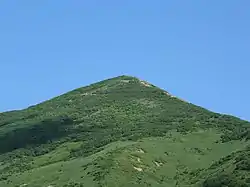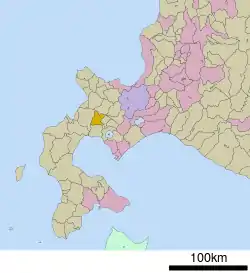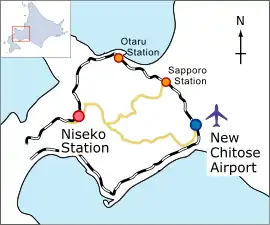Niseko
ニセコ町 | |
|---|---|
Town | |
 Summer in Niseko Annupuri, one of the most famous mountains for downhill skiing in Hokkaido. | |
 Flag  Seal | |
 Location of Niseko in Hokkaido (Shiribeshi Subprefecture) | |
 Niseko Location in Japan | |
| Coordinates: 42°48′N 140°41′E / 42.800°N 140.683°E | |
| Country | Japan |
| Region | Hokkaido |
| Prefecture | Hokkaido (Shiribeshi Subprefecture) |
| District | Abuta |
| Government | |
| • Mayor | Kenya Katayama |
| Area | |
| • Total | 197.13 km2 (76.11 sq mi) |
| Population (30 September 2016) | |
| • Total | 4,938 |
| • Density | 25/km2 (65/sq mi) |
| Time zone | UTC+09:00 (JST) |
| City hall address | 47, Aza Fujimi, Niseko-chō, Abuta-gun, Hokkaidō 048-1595 |
| Website | www |
| Symbols | |
| Bird | Great spotted woodpecker |
| Flower | Lavender |
| Mascot | Nicky (ニッキー) and Anicky (アニッキー) |
| Tree | Japanese white birch |

Niseko (Japanese: ニセコ町, Niseko-chō, [ɲ̟iseko tɕoː]) is a town located in Shiribeshi Subprefecture, Hokkaido, Japan. Niseko as a resort area refers to the Niseko area (ニセコ地域), or the Niseko tourism zone (ニセコ観光圏), which consists of the three towns of Kutchan, Niseko, and Rankoshi at the foot of Niseko Annupuri.[1][2]
The name Niseko is derived from the Nisekoanbetsu River (ニセコアンベツ川), meaning "river toward the cliff" in the Ainu language.[3]
The Niseko town's main industries are agriculture and tourism. The resort itself, Niseko United, is part of the Mountain Collective. Moreover, the town is renowned for its quality powder snow and world-class facilities, including traditional onsen and restaurants.[4]
Town
The town had an estimated population of 4,938 as of 30 September 2017, and a density of 25/km2 (65 inhabitants per square mile). The total number of visitors during the 2009 winter season was 201,000.[5] The total area is 197.13 km2 (76.11 square miles).
History
Since the present urban area of Niseko Town is located at the confluence of the Makkari and Shiribetsu Rivers, it was called "Makkari pet putu" (lit. 'mouth of the Makkari River') in Ainu, and came to be called "Makkari Bepputo" (真狩別太) in Japanese.[6]
Later, when the lower reaches of the Makkari River were divided from Makkari Village in 1901, the new village was named Kaributo Village (狩太村), short for Makkari Bepputo.[6]
In 1950, Kaributo Village was promoted to Kaributo Town (狩太町). In 1963, the Niseko Annupuri area was designated as "Niseko-Shakotan-Otaru Kaigan Quasi-National Park," and the following year, 1964, the name of Kaributo Town was changed to Niseko Town to promote tourism.
The name Niseko originally comes from the Nisekoanbetsu River. Nisekoanbetsu is derived from the Ainu word "Nisei ko an pet," which translates directly to "river toward the cliff."[3] The mountain that is the source of the river was called "Nisei ko an nupuri" (lit. 'the mountain of the Niseko [Anbetsu] River') in Ainu, or Niseko Annupuri in Japanese, with "nupuri" meaning mountain.[6]
As a result, Niseko has come to refer to the area at the foot of Niseko Annupuri. For this reason, the town's name change was vehemently opposed by neighboring towns, which claimed that the name "Niseko" would be stolen.[7]
Because of this, a distinction is made in Japan between Niseko Town and the Niseko area as a resort. Currently, the Niseko resort area includes the three towns of Kutchan, Niseko, and Rankoshi Town, which are designated as the "Niseko Tourism Zone" under Japan's Tourism Zone Development Law (enacted in 2008).[1]
Geography
Niseko Town is located at 140 degrees 48 minutes east longitude and 42 degrees 52 minutes north latitude. It is surrounded by the mountains of Mount Yōtei (1,898m), a national park, to the east and Niseko Annupuri (1,309m), a national park, to the north, forming a hilly basin with many wave-like slopes.[8]
The Shiribetsu River (the clearest river in Japan in 2004) flows through the center of the town, and small and medium-sized rivers such as the Konbu River, Nisekoanbetsu River, and Makkari River flow into it.
Climate
Niseko Town has a plateau-like environment with mountains on all four sides, which gives it a slightly continental climate, with relatively hot summers and cold winters.
Spring and autumn are generally mild, but the rainy season and early and late frosts often affect agriculture. Summer rainfall is also quite heavy. The most characteristic feature is winter, when the northwesterly monsoon brings moisture from the Sea of Japan, which is blocked by the Yotei-Niseko mountain range, resulting in snowfall. In summer, the winds are mostly from the southeast and southwest, and in winter, as mentioned above, the northwesterly winds are strong, but relatively mild compared to the rest of Hokkaido.
The average annual temperature is 6.7℃, with August having the highest temperature at 20.5℃ and January having the lowest at -6.0℃.
Annual precipitation is 1,498.5 mm, with relatively heavy precipitation from August to February and the heaviest precipitation from December to January. Compared to other regions in Hokkaido, the summer months have slightly higher temperatures and less precipitation, while the winter months have cooler temperatures and more precipitation.[9]
The Niseko area is one of the heaviest snowfall areas in Hokkaido, with a total annual snowfall of 1,243 cm. Snowfall is particularly heavy from December to February, with more than 25 days of snowfall.[9]
The resort is internationally renowned for its consistently good falls of light powder snow and its long ski season which runs from late November until early May. The snow is not as dry as other areas in Hokkaido, but the volume is high, with the average snow depth in March reaching 351 cm (138 inches).
Niseko was named as the world's No. 2 snowiest resort in December 2007 with annual average snowfall of 15.1 m (595 inches).[10] First place went to the Mt. Baker Ski Area in Washington State with 16.3 m (641 inches).
Population
The total population of Niseko Town on January 1, 2023 was 5,088 (including foreigners), with 2,560 males and 2,528 females.[11]
The population decreased from 1920 to 1940, but increased temporarily after World War II. However, the population began to decline again around 1960, when depopulation began to become more pronounced nationwide, and by 1980 it had dropped to less than half of its 1920 level. Since then, the population has remained flat, although there have been some fluctuations.[9]
Resort
Niseko is composed of seven ski areas, in order of size:
- Niseko Hirafu
- Niseko Village (formerly known as Niseko Higashiyama)
- Niseko Annupuri
- Niseko Hanazono
- Niseko Moiwa
- Niseko Weiss
- Park Hyatt

Niseko Mt. Resort Grand Hirafu, refers to the combined areas of Hirafu and Hanazono. Both of these and Weiss are within the municipality of nearby Kutchan. The other three resorts are within the adjacent municipality of Niseko.
Of these six ski areas, the main four (Annupuri, Higashiyama, Hirafu, and Hanazono) are sequentially interconnected and may be skied on one ski pass. The lift systems are owned respectively by the Chuo Bus company, YTL Resorts (which purchased Niseko Village from Citigroup in 2010), Tokyu Corporation and Pacific Century Premium Developments. Together they form 8.87 km2 (2,191 acres) skiable of what is known as the Niseko United. The lift system comprises 38 gondolas and lifts connecting 61 ski runs and 12 terrain parks. Kutchan's sister city is St. Moritz in a relationship established in 1964. Niseko Moiwa, adjacent to Annupuri, can be skied to from Annupuri but is not currently connected by the lift system. Niseko Weiss has not operated its lifts for decades, but people can still ski in this area, being taken uphill by snowcats.
Niseko also has backcountry ski-courses that are unofficially on the maps. To the furthest right of Annupuri lies Sannozaka, an area prone to avalanche but with high quality snow. To the far right of Hirafu lies Higashi One, also prone to avalanche but with challenging backcountry terrain. Near the lower half of Hanazono is a forest route called 'Strawberry Fields', which is perhaps the most famous run in Niseko. Mount Yōtei is also a popular mountain for backcountry skiing expeditions.
For the first time, in March 2008, Niseko was voted into the world's top 10 ski resorts. Coming in at No. 6 it was the highest ranked of the new entries in the poll.[10]
Originally known primarily for winter sports, Niseko has gradually gained a reputation as a center for a wide variety of summer activities, including golf, tennis, fishing, horseback riding, sea kayaking, white water rafting, trekking, and bicycling.[12]
Niseko has also become well known for its hot springs (onsen), diverse culinary choices, and exceptional whiskeys.[13]
Infrastructure and development
Niseko, although a growing area, does lack public and private infrastructure in certain areas. Simple public items such as street lighting and winter footpath clearing are left wanting in comparison to other international ski resorts (though this is common in rural Japan). Private infrastructure includes shopping and retail areas from which both are still in growth phase. These facilities are now available in Shiki building in central Hirafu where there is a supermarket, restaurants, a cafe and tour desk. Significant infrastructure development – initially focused on the road heating and redevelopment of the main street "Hirafu-zaka" – has now been completed as well as removing the overhead power lines and relocating them underground.
Counteracting this lack of infrastructure is the high demand for real estate. Foreign-owned companies are developing in the area along with Japanese companies. Purchase demand has expanded from Australian markets to include Hong Kong, Singapore and mainland China.
Nightlife and accommodation can be found across the district, Niseko Village/Annupuri/Moiwa is home to many of the established hotel properties, such as the Hilton Niseko Village and The Green Leaf Hotel, Northern Resort Annupuri, Hotel Ikoi no mura and Hotel Kanronomori, Grand Hotel and Hotel Ashiri Niseko. In Hanazono the all new Mountain Center was just finished and the extensive Hyatt Hotel is near completion. The Hirafu area is home to established and newer hotels as well as much of the district's condominium style accommodation.
Transportation
Niseko is located in the southwestern part of Hokkaido. The nearest airport is New Chitose Airport. Japan Rail Hokkaido, taxis, limousines and rental vehicles are some of the options to get to Niseko. The journey from the airport takes around 2 hours and 30 minutes. Niseko has day trips to many of the surrounding areas.
The Hokkaidō Shinkansen (bullet train) linking Kutchan (倶知安) with Tokyo and Sapporo is scheduled to open in March 2031.
Conferences
Niseko Town completely renovated and reopened its Community Hall as a conference center in January 2012.
Education

Hokkaido International School (HIS) in Niseko is a private, coeducational day school that offers a western-style education from pre-school through 6th grade for students of all nationalities. English is the language of instruction. The school was established in 2011 and is a branch of Hokkaido International School in Sapporo. HIS Niseko and HIS Sapporo are the only international schools on the island of Hokkaido.[14]
See also
References
- 1 2 "ニセコ観光圏整備計画" [Niseko Tourism Zone Development Plan] (PDF) (in Japanese). Rankoshi Town, Niseko Town, Kutchan Town. 2023. Retrieved 17 December 2023.
- ↑ "ニセコ観光圏" [Niseko Tourism Zone] (in Japanese). Niseko Kankouken. 2023. Retrieved 17 December 2023.
- 1 2 Nagata, Hōsei (1891). 北海道蝦夷語地名解 第1-3篇 [A Dictionary of Ezoic Place Names in Hokkaido, Vols. 1-3.] (in Japanese). Hokkaido. p. 226. doi:10.11501/992037.
- ↑ Japan External Trade Organization Hokkaido Trade Information Center, ed. (January 2006). ニセコ地域における外国人の観光と投資状況に関する報告書 [Report on the status of foreign tourism and investment in the Niseko area] (in Japanese). Japan External Trade Organization (JETRO).
- ↑ Snow Place Like Home – Monocle, 10 February 2010
- 1 2 3 Yamada, Shūzō (30 November 2018). 北海道の地名 [Place Names in Hokkaido]. Studies on Ainu Place Names, Supplementary Volume (in Japanese) (2 ed.). Urayasu City: Sōfūkan. p. 464. ISBN 978-4-88323-114-0.
- ↑ The Asahi Shimbun Hokkaido Branch, ed. (1968). 火の山 [Fire Mountain]. Hokuensha. p. 80. doi:10.11501/2974871.
- ↑ Niseko Town History Compilation Committee, ed. (March 1982). ニセコ町史 [History of Niseko Town] (in Japanese). Niseko Town. doi:10.11501/9570779.
- 1 2 3 "平成15年度 ニセコ町地域新エネルギービジョン策定報告書" [2003 Niseko Town Regional New Energy Vision Development Report] (PDF) (in Japanese). Niseko Town. February 2004. Retrieved 18 December 2023.
- 1 2 "Top 20 Snowiest Ski Resorts in the World – ForbesTraveler.com". Archived from the original on 11 January 2008. Retrieved 21 January 2008.
- ↑ "ニセコ町人口統計" [Niseko Town Population Statistics] (in Japanese). Niseko Town. 2023. Retrieved 18 December 2023.
- ↑ Yoshino, Michiru, "Hirafu-Niseko's powder melts hearts", Japan Times, 17 November 2006, p. 24.
- ↑ O'Grady, Janet (13 February 2020). "36 Hours in Niseko". The New York Times.
- ↑ "Hokkaido International School: About HIS Niseko". home.his.ac.jp. Retrieved 3 July 2017.
External links
- his.ac.jp, Hokkaido International School in Niseko
External links
- Official Website (in Japanese)